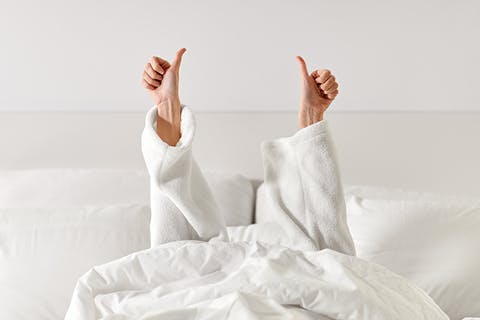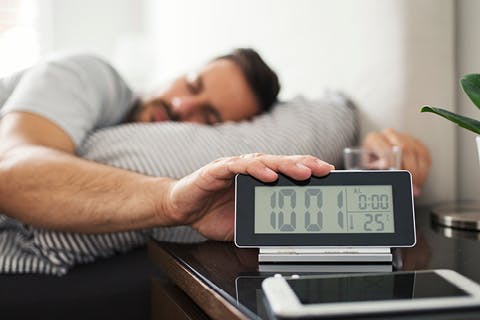What is my sleep chronotype? Finding your natural routine

It could be because of your sleep chronotype if you struggle to get up in the morning or find that your peak time for getting things done is late at night.
Related to your circadian rhythm, your chronotype is your body’s natural preference to fall asleep and wake up at certain times. Knowing your chronotype can help you create a sleep routine that suits your body’s natural cycle, leaving you feeling rested and refreshed. Let’s look at how to figure out your chronotype and use it to schedule your day.
What is a chronotype?
Before we delve into the different chronotypes, it’s important to know what we’re talking about. Researchers have been looking into chronotypes since the 1970s. While it might not be a new concept, much has been discovered about this interesting phenomenon that seems to impact our sleep routines.
The Four Chronotypes
You might have heard of a night owl or a morning lark, but what about the bear, lion, wolf and dolphin? These four animals have quickly become the most popular way to categorise our sleep patterns. They each represent four categories - early risers/early sleepers, late risers/late sleepers, somewhere in the middle, and fragmented sleepers.
How knowing your chronotype can help day-to-day
While it can be fun to compare chronotypes, they also greatly impact how you manage day-to-day. Take work schedules, for example. The average 9-5 workday is generally set up for early risers and those in the middle. In contrast, someone who is naturally more alert at night and wakes up later may struggle with their sleep quality and well-being on a 9 to 5 schedule. By understanding their chronotype, they can develop strategies to help adjust their routines and minimise drowsiness, lack of focus and other issues that come with poor sleep.
Which chronotype are you?
Now, it’s time for the fun part - finding out what chronotype you are. Sleep expert Dr. Michael Breus, a researcher in this field, has developed the sleep chronotype test to help people figure out where they sit. He classifies chronotypes into 4 categories: bears, lions, wolves, and dolphins.

Lion chronotype
Are you an early riser, feeling most productive in the morning? You may be a lion chronotype. Like their wild counterparts, Lions are early risers who thrive in the morning. They don’t struggle to get out of bed, with their energy levels peaking just before noon.
You may be a lion chronotype if:
- You work best in the morning
- You lose energy around midday
- At night, you have no problem sinking into bed
Ideal Lion Sleep routine:
Your sleep routine may align with your needs if you resonate with the lion chronotype. By being naturally welcoming of sleep, a pre-bedtime routine will likely be a nice added benefit to lull you. It’s just as likely you already slip into bed and doze off fairly easily.

Bear chronotype
Do you find getting out of bed a struggle, even after a full 8 hours of sleep? You’re not alone, with around 55% of the population also finding mornings a struggle. If this sounds like you, the bear could be your chronotype. Even after 8 hours of sleep, bears aren’t jumping up feeling refreshed. Instead, they slowly begin to pick up momentum as the day progresses.
You may be a bear chronotype if:
- Getting out of bed is difficult, even after a full 8 hours of sleep
- You reach peak productivity in the mid-to-late mornings
- You experience that 3pm afternoon slump
Ideal Bear Sleep Routine:
Consider adding soothing exercises to your bedtime routine if you resonate with a bear chronotype. This will help you fall asleep sooner and improve your sleep quality. Something as simple as chamomile tea before bed or limiting the use of electronic devices (such as mobile phones and tablets) can help prepare you for a deeper night’s sleep.

Wolf chronotype
If you feel energised as the sun sets, you could be a wolf chronotype. The wolf is the night owl of the pack. In the morning, wolves love to hit the snooze button and prefer a more gradual start to the day.
You may be a wolf chronotype if:
- You’ve got multiple alarms set in the morning (or tend to hit that snooze button)
- You are most productive at night, even getting a second wind in the early morning hours.
- You have no issue working past midnight.
Ideal Wolf Sleep Routine:
If you identify with the wolf chronotype, you may have avoided the regular 9-5 job to suit your sleep patterns better. For those who align themselves with the wolf in a 9-5, you may struggle to fall asleep early enough to get your full 8 hours—making the mornings feel difficult. The good news is that you can alter your routine to help make you a morning person over time, which can help you better adjust your working schedule. Things like:
- Leaving your phone or other temptations out of the bedroom
- Make your bed a place of rest only (i.e. reading a book or watching YouTube elsewhere)
- Indulging in a soothing cup of tea 30 minutes before bedtime
They are all small but effective changes that may help turn that morning battle into a welcome start.

Dolphin chronotype
Do you find it difficult to fall into a deep sleep? You may align with the dolphin chronotype — If you didn’t know, wild dolphins sleep with half of their brain switched on at all times - helping them stay alert. It’s a fitting name for this chronotype, characterised by light and restless sleeping patterns.
You may be a dolphin chronotype if:
- You have trouble getting enough deep sleep
- You often have light and restless sleep
- You feel lethargic in the mornings but pick up by mid-morning
- You are most productive in the afternoons
Ideal Dolphin Sleep Routine
If the dolphin chronotype sounds familiar, include some relaxing evening bedtime routines. Things such as a warm bubble bath, a chamomile tea, reading a book or listening to soothing music before sinking into bed can all help prepare your body for a deeper sleep—something this chronotype generally needs.
If learning about chronotypes has made you realise you’re on the wrong schedule for your type, try making small changes toward a lifestyle that better reflects your natural sleep pattern. Once you know your ideal bedtime, try these tips to ensure you have the perfect wind down.
References:
https://www.sleepfoundation.org/how-sleep-works/chronotypes
https://journals.sagepub.com/doi/10.1177/0748730415603835
https://onlinelibrary.wiley.com/doi/full/10.1111/j.1365-2869.2007.00580.x
https://www.tandfonline.com/doi/abs/10.1080/07420520500545979?journalCode=icbi20
https://www.chronobiology.com/simple-routine-adjustments-could-reduce-night-owl-health-risks/
https://thesleepdoctor.com/how-sleep-works/chronotypes/
https://thesleepdoctor.com/sleep-quizzes/chronotype-quiz/
https://www.sciencefocus.com/news/why-night-owls-shouldnt-have-to-start-work-at-9am/